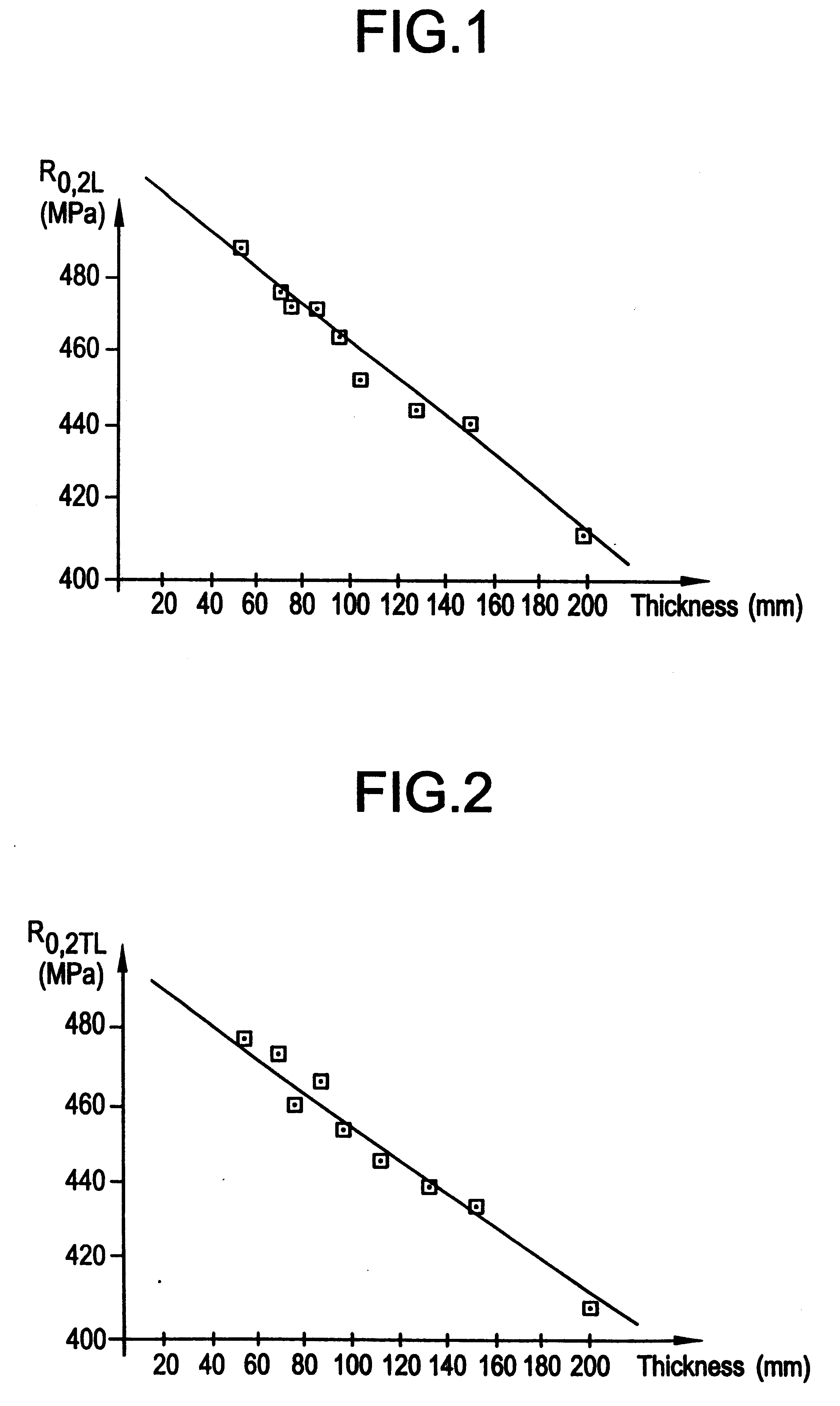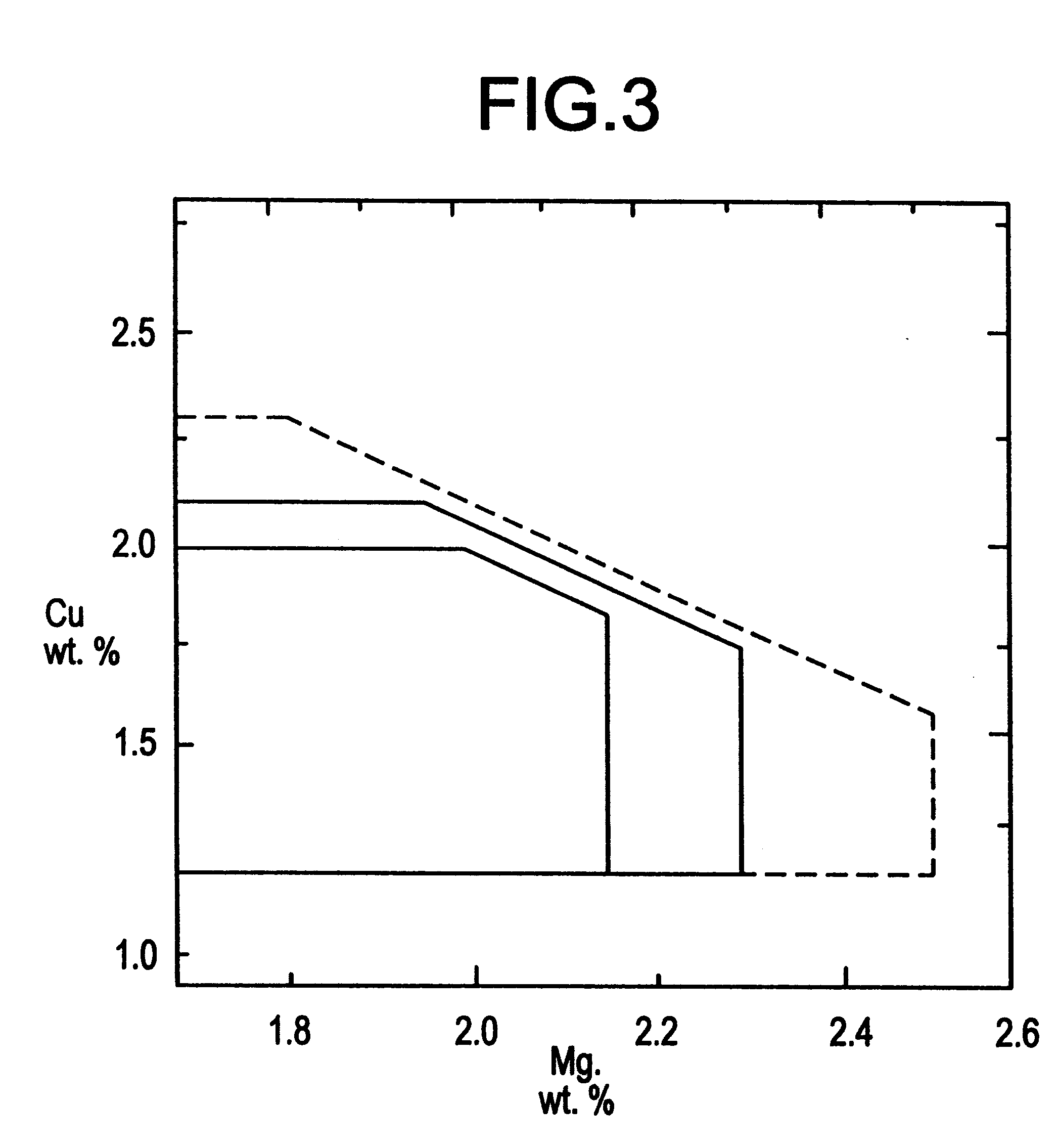Thick alznmgcu alloy products with improved properties
a technology of thick alznmgcu and alloy products, applied in the field of thick alznmgcu alloy products with improved properties, can solve the problems of increased risk of thick products, product quench sensitive, and difficult precise definition,
- Summary
- Abstract
- Description
- Claims
- Application Information
AI Technical Summary
Problems solved by technology
Method used
Image
Examples
example 1
Nine plates were cast, 3 of the standard alloy 7050, 3 with an alloy designated F according to the invention and 3 with an alloy X according to the invention, with the following composition (% by weight):
The nine plates were then scalped and homogenized to 475.degree. C. (7050) and 465.degree. C. (alloys F and X), respectively, and one plate of each alloy was rolled to a thickness of 130 mm, another to 150 mm, and the third to 200 mm. The inlet temperatures of the rolling were between 410 and 420.degree. C. for the three alloys. The outlet temperatures of the rolling were between 425 and 440.degree. C. All 9 plates were solution heat treated to 480.degree. C., quenched by immersion in cold water and stretched with a deformation rate on the order of 2%. The plates were then subjected to a two-stage aging:
6 h at 120.degree. C. and 17 h at 165.degree. C. for the plates made of alloy 7050,
6 h at 115.degree. C. and 10 h at 172.degree. C. for the plates made of alloys F and X.
The conventi...
example 2
Two alloys were cast, the first of which had a composition according to the invention (alloy G), the second of which was a standard alloy 7050. The compositions of these alloys are shown in Table 2.
The cast plates were homogenized at around 470.degree. C. and rolled in three passes to a thickness of 6 inches (152 mm), 7.5 inches (190 mm), or 8 inches (203 mm), as indicated in Table 3. The outlet temperatures of the rolling are also indicated in Table 3. The plates were solution heat treated at 480.degree. C., quenched by immersion in cold water, and subjected to a controlled traction with a deformation rate of 2%. The plates were then subjected to a two-stage aging:
6 h at 115.degree. C. and 10 h at 172.degree. C. for the plates of alloy G (according to the invention),
6 h at 120.degree. C. and 17 h at 165.degree. C. for the plates of alloy 7050 (prior art).
For each alloy-thickness combination, the yield strength R.sub.0.2 was measured at quarter-thickness in the L and TL directions, ...
example 3
Five types of alloys were cast, the compositions of which are shown in Table 4. The alloy A is a standard 7050, the alloy B is a 7050 optimized with a low MG content. The alloys C, D and E have compositions according to the invention. The cast plates were homogenized at around 470.degree. C. and hot rolled to thicknesses of 8 inches (203 mm), or 8.5 inches (215 mm). The plates were then solution heat treated at 480.degree. C., quenched by immersion in cold water, and subjected to a controlled traction with a deformation rate of 2%. The plates were then subjected to a standard two-stage aging with a first stage between 115.degree. C. and 120.degree. C., and a second stage around 170.degree. C., this two-stage treatment being characterized by an equivalent time t(eq) between 950 hours and 1,580 hours, expressed by the equation: ##EQU1##
in which T (in Kelvin) indicates the temperature of the heat treatment which continues for a time t (in hours), and T.sub.ref is a reference temperatur...
PUM
| Property | Measurement | Unit |
|---|---|---|
| Length | aaaaa | aaaaa |
| Fraction | aaaaa | aaaaa |
| Fraction | aaaaa | aaaaa |
Abstract
Description
Claims
Application Information
 Login to View More
Login to View More - Generate Ideas
- Intellectual Property
- Life Sciences
- Materials
- Tech Scout
- Unparalleled Data Quality
- Higher Quality Content
- 60% Fewer Hallucinations
Browse by: Latest US Patents, China's latest patents, Technical Efficacy Thesaurus, Application Domain, Technology Topic, Popular Technical Reports.
© 2025 PatSnap. All rights reserved.Legal|Privacy policy|Modern Slavery Act Transparency Statement|Sitemap|About US| Contact US: help@patsnap.com



